Exploring Precursors of Construction Accidents in China: A Grounded Theory Approach
Abstract
1. Introduction
2. Literature Review
2.1. Construction Accidents and Safety Management
2.2. Precursors and Their Management in Construction Projects
2.3. Grounded Theory in Construction Sector
3. Research Method
3.1. Data Collection
3.2. Data Analysis
3.2.1. Open Coding
3.2.2. Spindle Coding
3.2.3. Selective Coding
3.3. Theoretical Saturation Test
4. Findings
5. Discussion
6. Limitations
7. Conclusions
Author Contributions
Funding
Acknowledgments
Conflicts of Interest
References
- Fang, D.; Wu, H. Development of a Safety Culture Interaction (SCI) model for construction projects. Saf. Sci. 2013, 57, 138–149. [Google Scholar] [CrossRef]
- Safe Work Australia, Work-Related Traumatic Injury Fatalities, Australia. 2017. Available online: https://www.safeworkaustralia.gov.au/system/files/documents/1812/work-related-traumatic-injury-fatalities-report-2017.pdf (accessed on 5 December 2019).
- Ministry of Emergency Management of the People’s Republic of China. Report on the Safety Situation of the Chinese Construction Industry in the First half of 2018. Available online: https://www.mem.gov.cn/gk/tzgg/tb/201807/t20180725_230568.shtml (accessed on 15 October 2019).
- Cheng, E.W.L. Construction safety management: An exploratory study from China. Constr. Innov. 2004, 4, 229–241. [Google Scholar] [CrossRef]
- Ministry of Housing and Urban-Rural Construction of China, Announcement of Safety Accidents in Production of Housing and Municipal Engineering. 2016. Available online: http://www.mohurd.gov.cn/zlaq/cftb/zfhcxjsbcftb/index.html (accessed on 23 August 2019).
- Zhou, Z.; Irizarry, J.; Li, Q.; Wu, W. Using grounded theory methodology to explore the information of precursors based on subway construction incidents. J. Manag. Eng. 2015, 31, 0401–4030. [Google Scholar] [CrossRef]
- NAO Engineering National Academy of Engineering. Accident Precursor Analysis and Management: Reducing Technological Risk through Diligence; The National Academies Press: Washington, DC, USA, 2004. [Google Scholar]
- Wu, W.; Gibb, A.G.F.; Li, Q. Accident precursors and near misses on construction sites: An investigative tool to derive information from accident databases. Saf. Sci. 2010, 48, 845–858. [Google Scholar] [CrossRef]
- Fang, D.P.; Xie, F.; Huang, X.Y.; Li, H. Factor analysis-based studies on construction workplace safety management in China. Int. J. Proj. Manag. 2004, 22, 43–49. [Google Scholar] [CrossRef]
- Saurin, T.A.; Formoso, C.T.; Cambraia, F.B. An analysis of construction safety best practices from a cognitive system engineering perspective. Saf. Sci. 2008, 46, 1169–1183. [Google Scholar] [CrossRef]
- Zhang, S.; Sulankivi, K.; Kiviniemi, M.; Romo, I.; Eastman, C.M.; Teizer, J. BIM-based fall hazard identification and prevention in construction safety planning. Saf. Sci. 2015, 72, 31–45. [Google Scholar] [CrossRef]
- Aneziris, O.N.; Papazoglou, I.A.; Baksteen, H.; Mud, M.; Ale, B.J.; Bellamy, L.J.; Hale, A.R.; Bloemhoff, A.; Post, J.; Oh, J. Quantified risk assessment for fall from height. Saf. Sci. 2008, 46, 198–220. [Google Scholar] [CrossRef]
- He, Q.; Dong, S.; Rose, T.; Li, H.; Yin, Q.; Cao, D. Systematic impact of institutional pressures on safety climate in the construction industry. Accid. Anal. Prev. 2016, 93, 230–239. [Google Scholar] [CrossRef]
- Chi, C.-F.; Yang, C.-C.; Chen, Z.-L. In-depth accident analysis of electrical fatalities in the construction industry. Int. J. Ind. Ergon. 2009, 39, 635–644. [Google Scholar] [CrossRef]
- Beavers, J.E.; Moore, J.R.; Schriver, W.R. Steel erection fatalities in the construction industry. J. Constr. Eng. Manag. 2009, 135, 227–234. [Google Scholar] [CrossRef]
- Low, B.K.L.; Man, S.S.; Chan, A.H.S.; Alabdulkarim, S. ConstructionWorker Risk-Taking Behavior Modelwith Individual and Organizational Factors. Int. J. Environ. Res. Public Health 2019, 16, 1335. [Google Scholar] [CrossRef]
- Makki, A.A.; Mosly, I. Determinants for Safety Climate Evaluation of Construction Industry Sites in Saudi Arabia. Int. J. Environ. Res. Public Health 2020, 17, 8225. [Google Scholar] [CrossRef] [PubMed]
- Turskis, Z.; Dzitac, S.; Stankiuviene, A.; Šukys, R. A Fuzzy Group Decision-making Model for Determining the Most Influential Persons in the Sustainable Prevention of Accidents in the Construction SMEs. Int. J. Comput. Commun. Control 2019, 14, 90–106. [Google Scholar] [CrossRef]
- Gul, M. A review of occupational health and safety risk assessment approaches based on multi-criteria decision-making methods and their fuzzy versions. Hum. Ecol. Risk Assess. 2018, 24, 1–38. [Google Scholar] [CrossRef]
- Zorrilla-Muñoz, V.; Petz, M.; Agullo-Thomas, M. Ergonomic risk factors analysis with multi-methodological approach: Assessing workers’ activities in buildings under construction. DYNA 2019, 94, 338–344. [Google Scholar]
- Bier, V.M.; Mosleh, A. The analysis of accident precursors and near misses: Implications for risk assessment and risk management. Reliab. Eng. Syst. Saf. 1990, 27, 91–101. [Google Scholar] [CrossRef]
- Kyriakidis, M.; Hirsch, R.; Majumdar, A. Metro railway safety: An analysis of accident precursors. Saf. Sci. 2012, 50, 1535–1548. [Google Scholar] [CrossRef]
- Fu, R.; Li, Q.; Wu, W.; Zhou, Z. Investigation on Precursor Signals of Safety Hazards on Construction Sites, Proceedings of 2008 International Conference on Construction & Real Estate Management; China Architecture and Building Press: Beijing, China, 2008; pp. 223–229. [Google Scholar]
- Liu, X.Z.; Zhao, T.S.; Xiao, K. Building the CBR-based identification system framework for construction accident precursors. Adv. Mater. Res. 2011, 255–260, 546–550. [Google Scholar] [CrossRef]
- Melo RRSd Costa, D.B.; Álvares, J.S.; Irizarry, J. Applicability of unmanned aerial system (UAS) for safety inspection on construction sites. Saf. Sci. 2017, 98, 174–185. [Google Scholar] [CrossRef]
- Li, H.; Lu, M.; Hsu, S.-C.; Gray, M.; Huang, T. Proactive behavior-based safety management for construction safety improvement. Saf. Sci. 2015, 75, 107–117. [Google Scholar] [CrossRef]
- Glaser, B.G.; Strauss, A.L. The Discovery of Grounded Theory: Strategies for Qualitative Research; Aldine and Atherton: Chicago, IL, USA, 1968. [Google Scholar]
- Zhou, Z.; Li, Q.; Wu, W. Developing a Versatile Subway Construction Incident Database for Safety Management. J. Constr. Eng. Manag. 2012, 138, 1169–1180. [Google Scholar] [CrossRef]
- Shojaei, P.; Haeri, S.A.S. Development of supply chain risk management approaches for construction projects: A grounded theory approach. Comput. Ind. Eng. 2019, 128, 837–850. [Google Scholar] [CrossRef]
- Wu, C.; Fang, D.; Li, N. Roles of owners’ leadership in construction safety: The case of high-speed railway construction projects in China. Int. J. Proj. Manag. 2015, 33, 1665–1679. [Google Scholar] [CrossRef]
- Fu, Y.; Ye, G.; Tang, X.; Liu, Q. Theoretical Framework for Informal Groups of Construction Workers: A Grounded Theory Study. Sustainability 2019, 11, 6769. [Google Scholar] [CrossRef]
- Li, K. Applying Grounded Theory Method in Building a Hybrid Learning Activities Model// International Conference on Hybrid Learning & Continuing Education; Springer International Publishing: New York, NY, USA, 2015. [Google Scholar]
- Birhanu, Z.; Ambelu, A.; Berhanu, N.; Tesfaye, A.; Woldemichael, K. Understanding Resilience Dimensions and Adaptive Strategies to the Impact of Recurrent Droughts in Borana Zone, Oromia Region, Ethiopia: A Grounded Theory Approach. Int. J. Environ. Res. Public Health 2017, 14, 118. [Google Scholar] [CrossRef] [PubMed]
- Hunt, A.; Faybishenko, B.; Ghanbarian, B.; Egli, M.; Yu, F. Predicting Water Cycle Characteristics from Percolation Theory and Observational Data. Int. J. Environ. Res. Public Health 2020, 17, 734. [Google Scholar] [CrossRef]
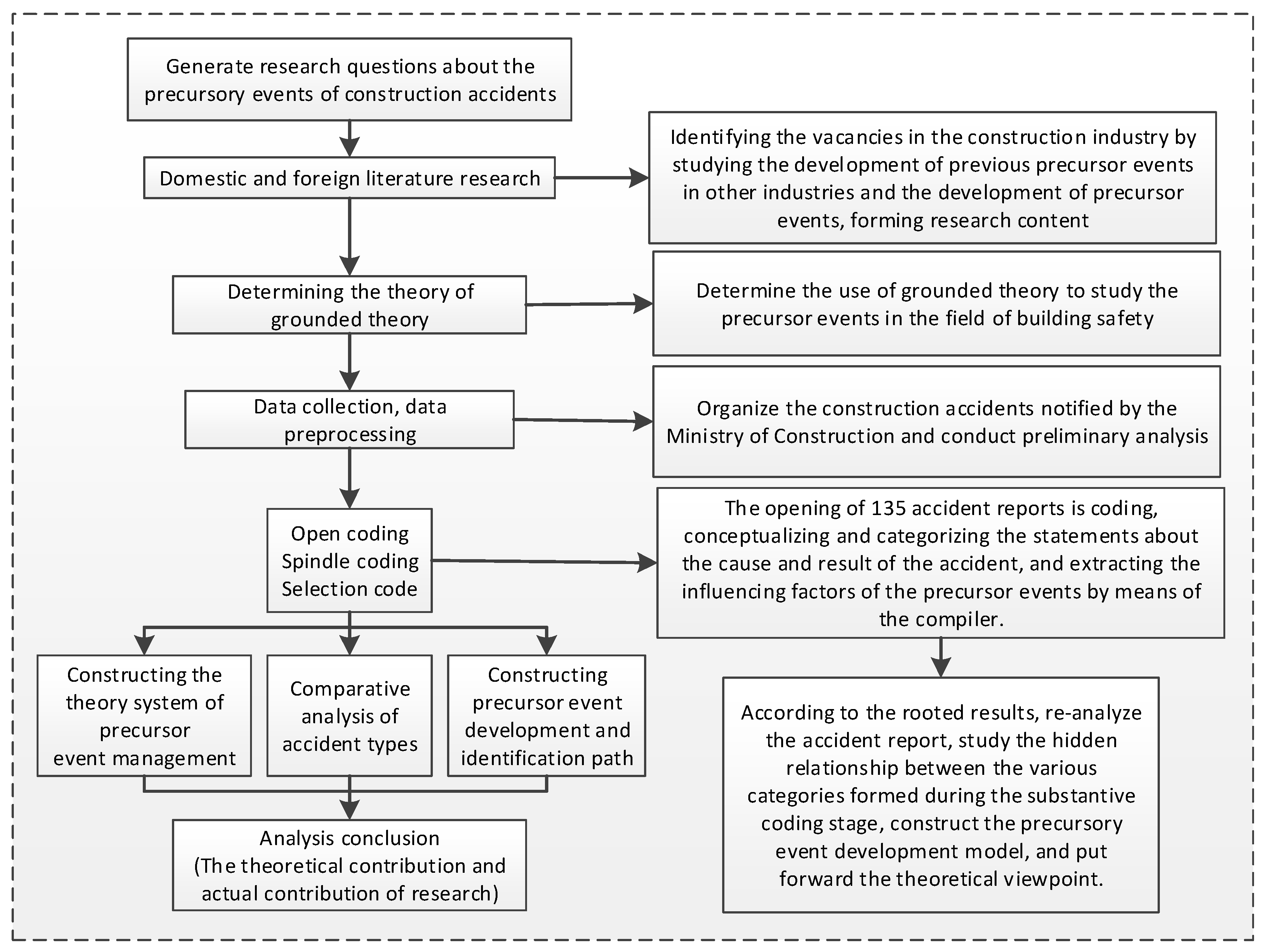
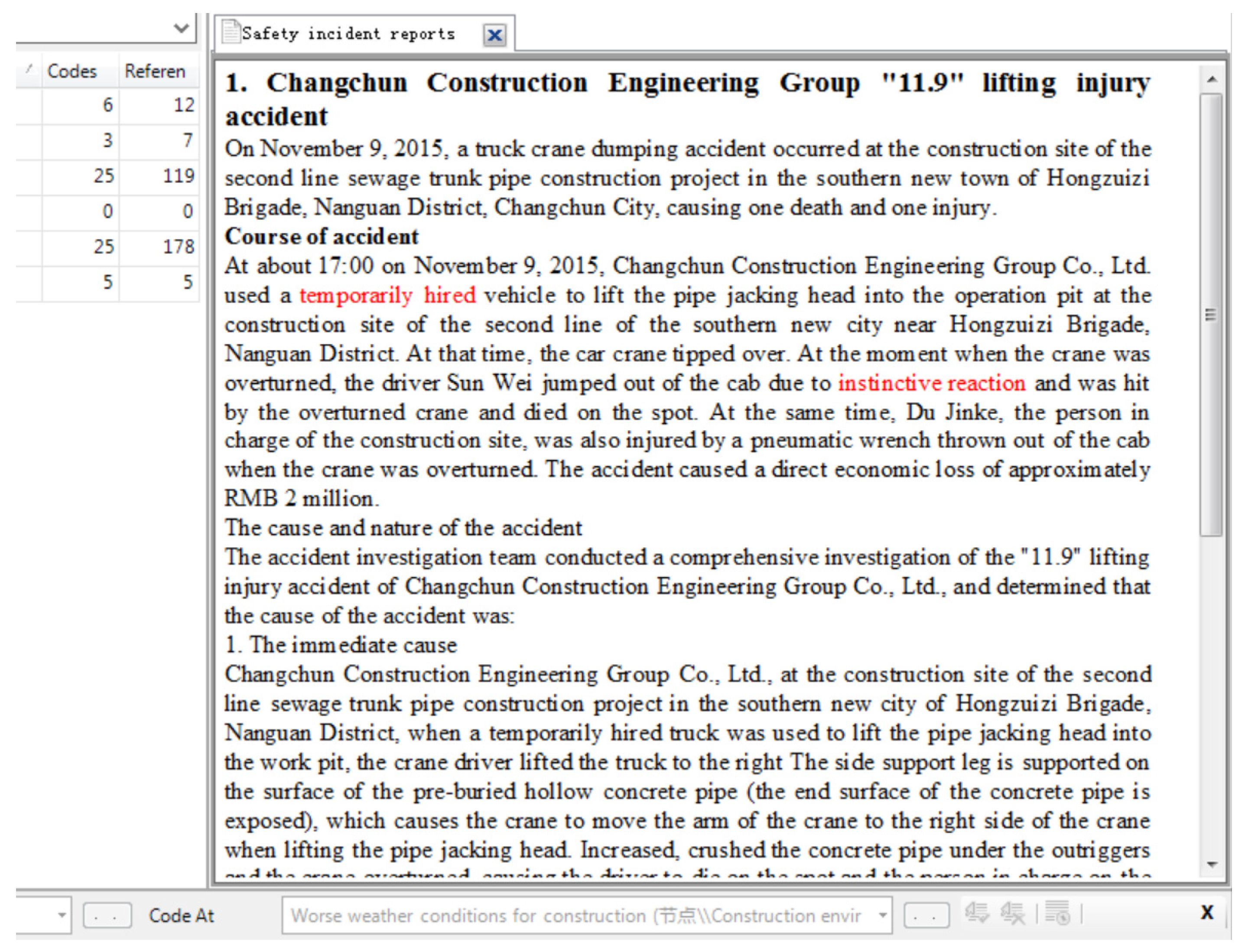
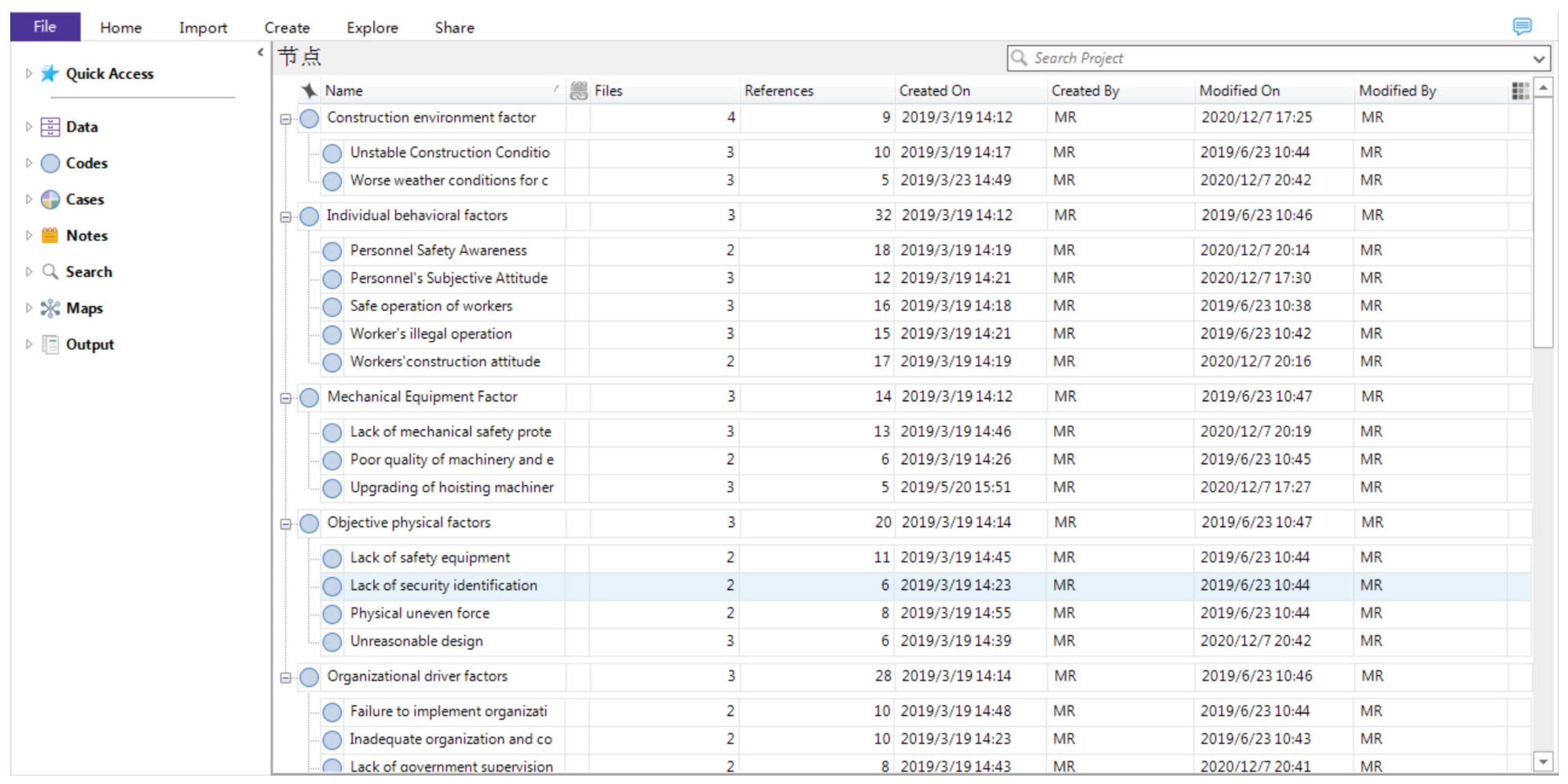
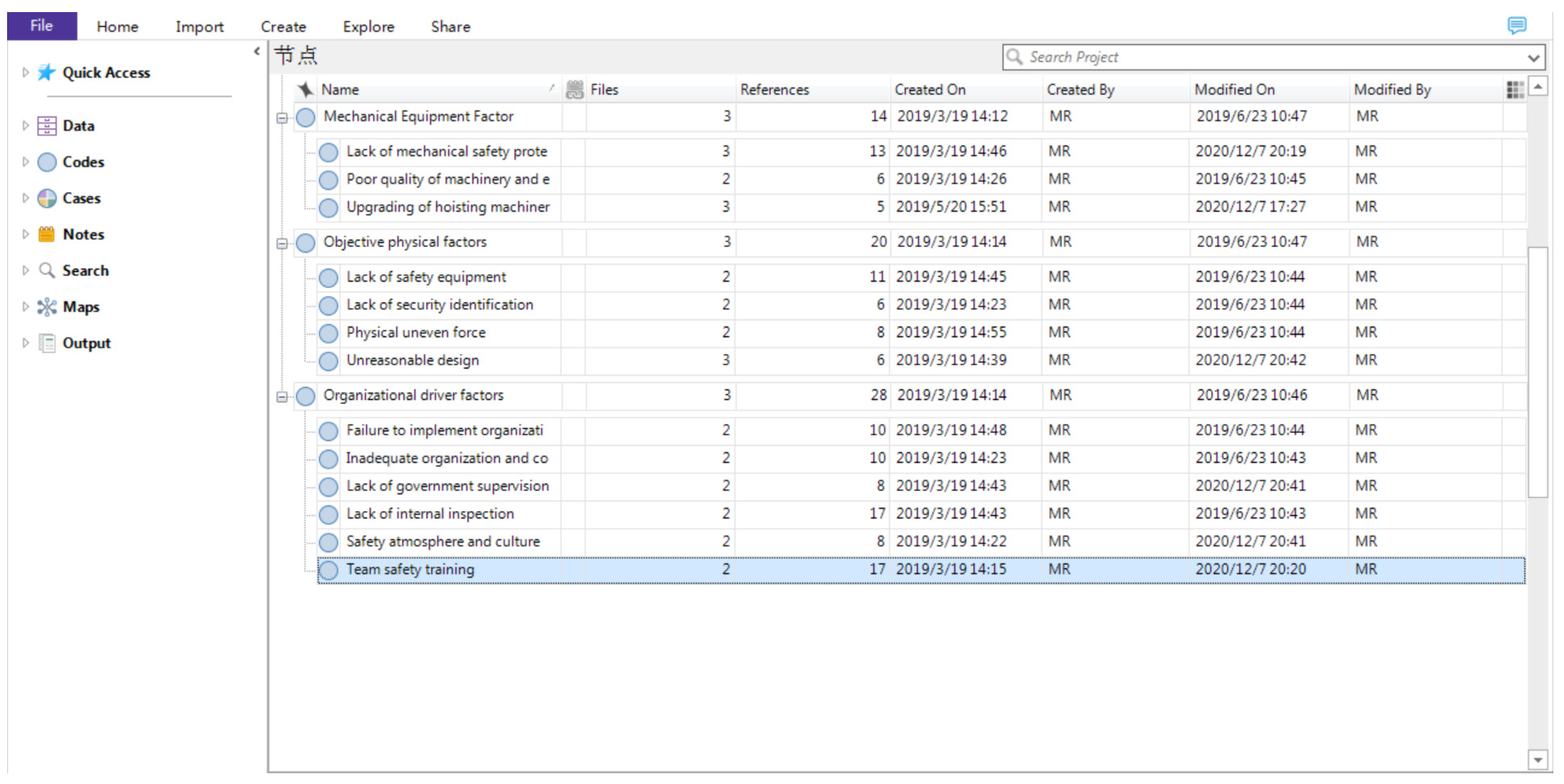
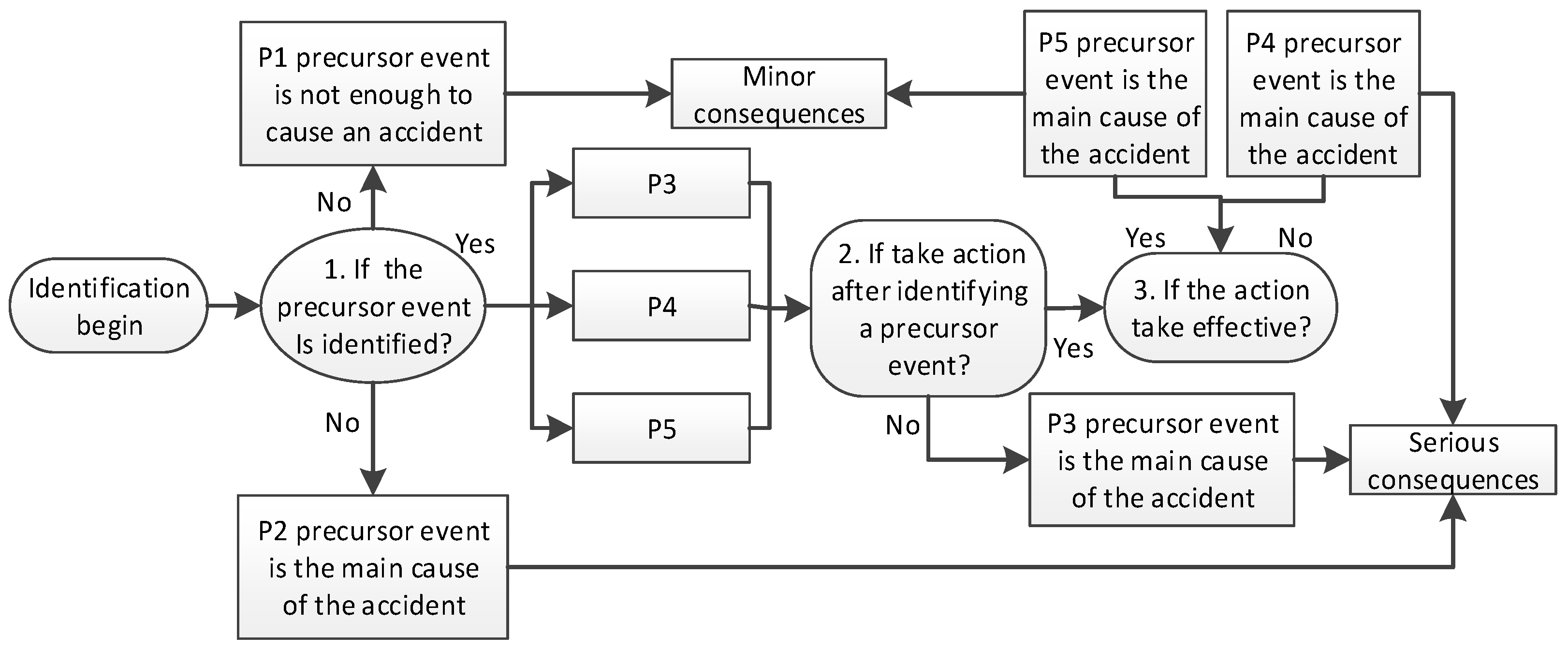
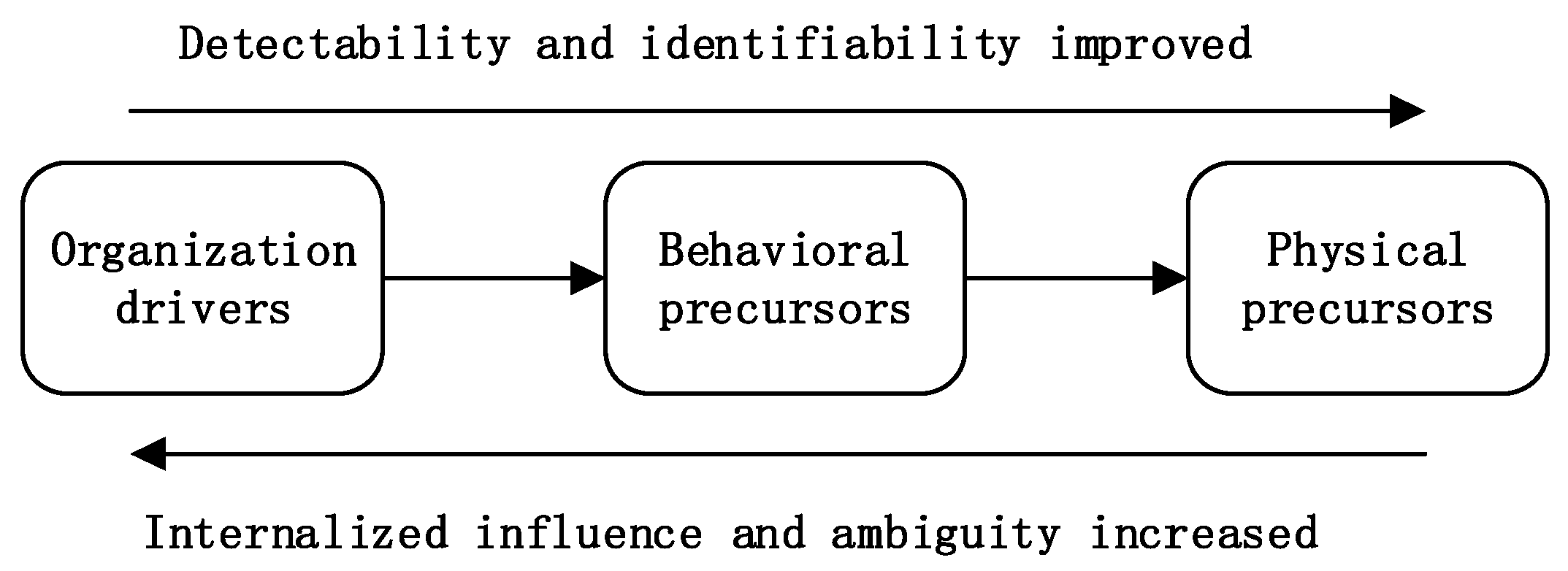
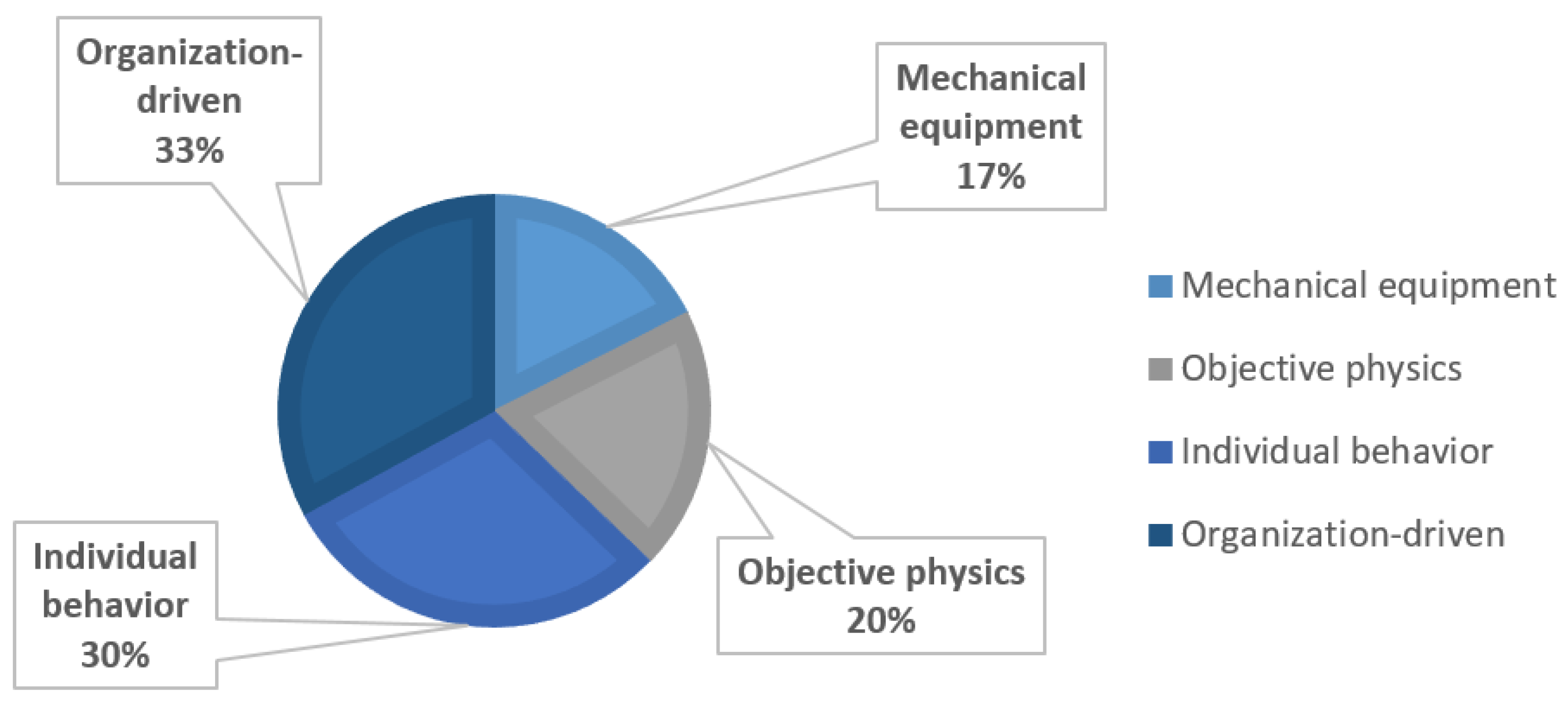
| Accident Type | Frequency | Construction Project Type | Frequency |
| Lifting equipment collapse | 31 | Urban infrastructure project | 24 |
| Building collapse | 29 | Plant construction and maintenance project | 35 |
| Object falling from high altitude | 26 | Civil residential project | 23 |
| Personnel falling from high altitude | 24 | National Engineering Construction Project | 9 |
| Fire accident | 14 | Public civil construction project | 19 |
| Electric shock accident | 11 | Commercial building project | 25 |
| Statistics of Accident Location | Frequency | Statistics of Casualties in Construction Accidents | Frequency |
| First-tier cities | 21 | Minor wound | 21 |
| Second-tier cities | 31 | Serious injury | 16 |
| Third-class cities | 49 | One to two deaths | 41 |
| Fourth-tier cities | 34 | Three to five deaths | 32 |
| More than five men died | 25 |
| Code | Original Statements Retrieved from Accident Reports | Frequency | Spindle Coding |
|---|---|---|---|
| H13 | The supervisor has not reviewed the authenticity of the data, the unqualified construction team’s operating qualifications and the operation permit. | 33 | Lack of checking |
| H29 | Incomplete construction procedures exist in construction units | 32 | Incomplete formalities |
| H27 | The inspectors have a fluke mentality and an incorrect attitude towards the inspection of safety links. | 30 | Worker attitudes and opportunism |
| H20 | Lack of real-time testing of construction workers to implement unsafe behavior instruments | 30 | Lack of equipment testing |
| H14 | The government’s safety management department has violated regulations and violated its regulatory obligations. | 28 | Lack of government regulation |
| H28 | The supervision unit failed to stop the structural design and checking calculation of the actual operation platform of the project in time. | 28 | Regulatory loopholes |
| H22 | The safety production rules and regulations are not perfect, and the safety production responsibility system is not in place. | 28 | Organizational system is not implemented |
| H11 | The old crane is out of repair and has not passed the safety check. | 27 | The quality of the lifting machinery is not good |
| H6 | Workers will not actively report the precursor of the accident | 25 | Human attitude |
| H21 | The crane does not have regular maintenance and inspection | 24 | Equipment maintenance |
| H25 | Weather conditions lead to poor construction conditions and mechanical instability. | 23 | Construction weather environment |
| H26 | The tower operator did not wear a seat belt. | 23 | Missing safety equipment |
| H4 | Managers and practitioners have a weak security awareness | 23 | Safety consciousness |
| H24 | Responsible persons and managers do not have the safety production knowledge and management ability of their production and operation activities. | 19 | Insufficient personnel capacity |
| H8 | Not communicating effectively with the driver of the crane | 19 | Organizational communication |
| H10 | Coordination work of various working groups is not in place, there are security risks | 17 | Coordination is not in place |
| H23 | Scaffolding steel pipe joints are loose, no necessary support | 16 | Infrastructure is at risk |
| H15 | Construction workers lack necessary safety equipment | 16 | Lack of safety equipment |
| H33 | The builders lack safety awareness and throw construction waste downstairs. | 15 | Safety consciousness Illegal operation |
| H5 | Temporary hiring personnel (including car hoists) fail to carry out safety technical disclosure and safety education training as required | 15 | Not operating according to the program Safety Training |
| H30 | Contractor did not adjust in time according to load test standard | 14 | Unreal-time adjustment of equipment parameters |
| H34 | Sequential operation failure of crane results in excessive force exerted on a crane arm. | 14 | Operational Sequence Error |
| H1 | Temporary employment of crane drivers without professional training | 13 | Safety Training |
| H18 | The construction materials are stacked against the wall, causing the wall to collapse due to uneven force. | 9 | Uneven objective physical force |
| H37 | The safety management system is not strictly enforced and no one is in charge of the construction site. | 8 | Security system implementation |
| H9 | Prohibition of missing warning signs such as crossings and danger sources | 6 | Missing identity |
| H32 | Over-excavation depth of excavator leads to overturning due to uneven stress on support surface | 5 | Objective physical factors |
| H35 | Construction personnel use lifts without safety devices | 5 | Lack of safety equipment |
| H3 | Failure to comply with the supervision requirements, the implementation of the inspection and safety inspection system for the car cranes entering the market | 5 | Not operating as required |
| H7 | Violation of the rules across the railing to the crane operating area | 4 | Violation operation |
| H17 | There are no relevant regulations for maintenance procedures. | 4 | Lack of organizational regulations |
| H36 | Heavy rain leads to wet and slippery ground, weakening the support strength of crane bracket, leading to crane collapse. | 3 | Bad weather |
| H2 | The side arm of the crane is fixed on the unstable ground (the exposed hollow pipe on the surface is not strong enough) | 3 | Unstable construction conditions No safe operation |
| H12 | The design of the support structure is unreasonable, and the support weight is not reached. | 3 | Unreasonable design |
| H16 | Overhauling workers in violation of regulations will simplify the process of requiring dedicated operations | 3 | Violation operation |
| H31 | 1.5 cm cracks appeared in the construction floor, which did not stop construction in time for repair. | 2 | Illegal operation Lack of supervision |
| H19 | The safety awareness is weak, and the crane that operates the torque limiter and the level fails is lifted in an uneven field. | 1 | safety consciousness |
| Classification | Sub-Category | The Connotation of Open Coding | Frequency |
|---|---|---|---|
| Behavioral factors 65.4% | Individual behavioral factors 36.2% | Personnel safety awareness | 31 |
| Safe operation of workers | 29 | ||
| Workers’ construction attitude | 25 | ||
| Worker’s illegal operation | 23 | ||
| Personnel’s subjective attitude | 22 | ||
| Organizational driver factors 29.2% | Team safety training | 24 | |
| Lack of internal inspection | 22 | ||
| Inadequate organization and coordination | 20 | ||
| Lack of government supervision | 18 | ||
| Safety atmosphere and culture | 12 | ||
| Failure to implement organizational system | 9 | ||
| Physical factors 34.4% | Objective physical factors 15.6% | Lack of safety equipment | 19 |
| Physical uneven force | 17 | ||
| Lack of security identification | 11 | ||
| Unreasonable design | 9 | ||
| Construction environmental factors 8% | Unstable construction conditions | 18 | |
| Worse weather conditions for construction | 11 | ||
| Mechanical Equipment factors 10.8% | Lack of mechanical safety protection | 18 | |
| Poor quality of machinery and equipment | 12 | ||
| Upgrading of hoisting machinery lags behind | 9 |
| Accident Types | Main Axis Representation of Leading Precursors | Frequency | Category of Precursors |
|---|---|---|---|
| Collapse—44.4% | Instability of hoisting equipment during construction | 17 | Mechanical equipment |
| Unconscious objective physical factors | 19 | Objective physics | |
| Failure to follow the prescribed operating procedures | 28 | Individual behavior | |
| Weak awareness of safety | 32 | ||
| Safety training and qualification examination are not in place | 21 | Organization-driven | |
| Lack of safety supervision | 29 | ||
| Falling from a height—37% | Lack of Safety Protection Equipment and Label | 19 | Objective physics |
| Weak awareness of safety | 25 | Individual behavior | |
| Personal unsafe behavior of constructors | 27 | ||
| Failure to follow the prescribed procedure | 30 | ||
| Insufficient safety supervision | 28 | Organization-driven | |
| Imperfect implementation of safety management system | 31 | ||
| Fire—10.3% | Building materials are not stored in accordance with regulations | 11 | Objective physics |
| Environmental factors at the construction site | 12 | ||
| Weak awareness of safety | 16 | Individual behavior | |
| Lack of inspection of infrastructure | 15 | Organization-driven | |
| Electric shock—8.1% | Lack of equipment testing | 19 | Mechanical equipment |
| Lack of Safety Protection Equipment and Label | 15 | Objective physics | |
| Failure to follow the prescribed operating procedures | 23 | Individual behavior |
| Number | Accident Details |
|---|---|
| P1 | High-altitude accident: The building scaffolding is not fixed, but because the location is not densely populated, the precursor events continue to evolve and do not cause serious safety incidents |
| P2 | Hubei Good Mansion lifting Collapse accident: the relationship workers did not find the overload of the lifting object, the problem of the lifting arm, the means of identifying the precursor, and the continued operation of the precursor and the emergence of the precursor, eventually leading to the overweight bearing of the boom, the crane collapsed, and this is a serious construction accident |
| P3 | Chang’an Town high altitude fall accident: The workers have found that the construction lifts are not equipped with safety gates and are in an unsafe state. However, due to the tight schedule, the organization is not strict with the construction process and there is opportunism that the probability of accidents is small and there is no unsafe condition for the machinery. Disposal leads to the occurrence of a high fall accident |
| P4 | When the worker finds that the crane driver is in the unlicensed driving state, the worker is under the pressure of the construction captain, the actual situation of the driver who lacks the driving of the license, and the atmosphere of the entire construction team not paying attention to the safe operation, the worker It is only reported to the construction team leader and informed the driver to pay attention to safety, and has not been directly reported to the owner, the contracting company, the supervisor, and the adoption of invalid evasive measures has led to serious construction consequences |
| P5 | Worker A found that the connection of the safety rope of the high-altitude operator B was in excessive wear state, then stopped the construction work B and reported to the superior supervision department and the logistics department, and timely replaced the lifting rope and handed it to the supervision department. The matter was accountable and found that it was B’s own reason that the rope was not replaced in time, and the corresponding punishment decision was made for B |
Publisher’s Note: MDPI stays neutral with regard to jurisdictional claims in published maps and institutional affiliations. |
© 2021 by the authors. Licensee MDPI, Basel, Switzerland. This article is an open access article distributed under the terms and conditions of the Creative Commons Attribution (CC BY) license (http://creativecommons.org/licenses/by/4.0/).
Share and Cite
Li, Z.; Mao, R.; Meng, Q.F.; Hu, X.; Li, H.X. Exploring Precursors of Construction Accidents in China: A Grounded Theory Approach. Int. J. Environ. Res. Public Health 2021, 18, 410. https://doi.org/10.3390/ijerph18020410
Li Z, Mao R, Meng QF, Hu X, Li HX. Exploring Precursors of Construction Accidents in China: A Grounded Theory Approach. International Journal of Environmental Research and Public Health. 2021; 18(2):410. https://doi.org/10.3390/ijerph18020410
Chicago/Turabian StyleLi, Zhen, Rui Mao, Qing Feng Meng, Xin Hu, and Hong Xian Li. 2021. "Exploring Precursors of Construction Accidents in China: A Grounded Theory Approach" International Journal of Environmental Research and Public Health 18, no. 2: 410. https://doi.org/10.3390/ijerph18020410
APA StyleLi, Z., Mao, R., Meng, Q. F., Hu, X., & Li, H. X. (2021). Exploring Precursors of Construction Accidents in China: A Grounded Theory Approach. International Journal of Environmental Research and Public Health, 18(2), 410. https://doi.org/10.3390/ijerph18020410







